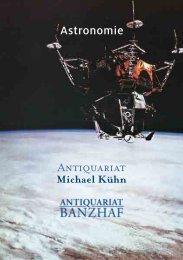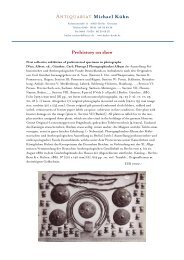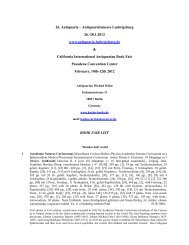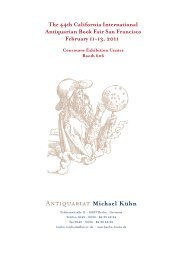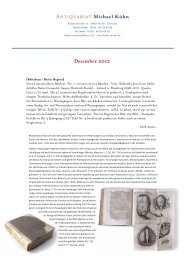List New York Antiquarian Book Fair - Antiquariat - Michael Kühn
List New York Antiquarian Book Fair - Antiquariat - Michael Kühn
List New York Antiquarian Book Fair - Antiquariat - Michael Kühn
You also want an ePaper? Increase the reach of your titles
YUMPU automatically turns print PDFs into web optimized ePapers that Google loves.
vatory magnets--big magnets, slow to respond, later replaced by more nimble instruments. In 1832 Gauss and<br />
Weber also devised a clever method of using an auxiliary magnet to measure not only the direction of the Earth's<br />
magnetic force, but also its intensity. Today undergraduate physics students use the Gauss method for measuring<br />
the strength of the Earth's field as a standard lab experiment, not realizing its historical significance. Actually it<br />
made possible for the first time a global network of magnetic observatories, because now every instrument could<br />
be calibrated locally, independently of any others. But perhaps the most lasting contribution was the use of a precise<br />
mathematical method to represent the global magnetic field of the Earth and to combine observations at<br />
many locations. That was spherical harmonic analysis, previously used for analyzing gravitational fields in celestial<br />
mechanics. According to Sidney Chapman, it was introduced to geomagnetism by the French mathematician<br />
Simeon Denis Poisson (1781-1840).- DSB. V, 298-315; Wheeler Gift Cat. 920; Ronalds 195; Bakken 205;<br />
Ekelöf Cat. 899. Dibner, Heralds of Science 66; Norman 883 & 882; not in Barchas Coll.<br />
Catalogue of a Mechanical cabinet<br />
[Mechanical Cabinet] Gabinetto Tecnologico dell’ I. R. Istituto Lombardo di Scienze, Lettere<br />
ed Arti.- Milano: coi Tipo di Giuseppe Bernardoni di Gio, 1846. 8° [220 x 154 mm] 55<br />
pp., [1, blank] Plain blue Wrappers, title stamped, fine uncut & unopened copy. $ 1600.-<br />
Rare Catalogue of the inventory of a technical cabinet in Milano. A lot of the machines / items were constructed<br />
& built by the Milanese engineer Luigi de Cristoforis (1798-1862) , who is renowned for the development of an<br />
early internal combustion engine: he was the first to use liquid fuel to fire an internal combustion engine, in<br />
1841, in a naphtha-fuelled machine. In 1857 he had settled in London, living at 67 Lower-Thames Street and<br />
working on a series of improvements and patents on wheeled vehicles.<br />
Das Mailänder “Raritätenkabinett” aus der Frühzeit der Industrialisierung enthielt in sechs Räumen Objekte wie<br />
ein “Veicolo che progredisce sopra palle”, sowie andere Fortbewegungsmittel, verschiedene Sägen, ein speziell<br />
konstruiertes Krankenbett, exotische Hölzer, Dampfmaschinen, Meßgeräte, Öfen, einen ‘Chiave con misura del<br />
tiempo’ et al. Alle vorgestellten Objekte mit kurzer Erläuterung.<br />
Astronomical Incunabla<br />
Gerard de Cremona [attr.] Theorica planetarum.- Venedig: Franz Renner von Heilbronn,<br />
1478. 20 Bll. Mit Gedicht an den Leser von Pescennius Franciscus Niger, Antiqua-Type, 25<br />
Zeilen. Mit Holzschnitt-Initialen, 8 astronomischen Holzschnitten. Halblederbd. d. 18. Jahrhunderts.<br />
$ 12000.-<br />
Early edition, first published in 1472. The authorship of the Theorica planterum has been controversial.<br />
According to a medieval tradition, the work was written by Gerard of Cremona. In the (older) scholarly literature<br />
(Nallino, Carmody, et al.), however, the work was attributed to Gerard of Sabbioneta. On the basis of newer<br />
manuscript evidence, it is highly likely that the Theorica planetarum was translated by Gerard of Cremona or<br />
someone from his circle. Gerard of Cremona (c. 1114–1187) was an Italian translator of Arabic scientific works<br />
found in the aban-doned Arab libraries of Toledo. He was one of the most important scholars among the Toledo<br />
School of Trans-lators who invigorated medieval Europe in the twelfth century by transmitting ancient Arabic,<br />
Greek and Jewish knowledge in astronomy, medicine and other sciences, and making them available to every<br />
literate person in Europe. One of his most famous translations is of Ptolemy's Almagest from Arabic texts found<br />
in Toledo. The text was often given with Sacrobosco’s Sphaera mundi, but a lot of libraries have the text alone<br />
and Bibl. cite it often separate.- Goff J-402; Proctor, 4175 Hain, 14108; Stillwell. The awakening interest in<br />
science no. 63. BSB I-500; GW M14655; The Theorica planetarum is usually considered to be by the Cremona<br />
astrologer Gherardo da Sab-bioneta, although some authorities ascribe it to the Gerardus Cremonensis who died<br />
1187.– DSB, Suppl., 189 for a summary of the evidence. Graziella Federici-Vescovini. Michel Scot et La "Theorica<br />
Planetarum Gerardi in: Early Science and Medicine 1 (1996), 272-282.<br />
Lavoisier as the <strong>New</strong>ton of Chemistry<br />
Girtanner, Christoph. Anfangsgründe der antiphlogistischen Chemie… zweite, verbesserte<br />
und stark vermehrte Auflage.- Berlin: bei Johann Friedrich Unger, 1795. 8°. [16], 466 pp. with<br />
engraved frontispiece portrait of Girtanner (D. Berger sc. 1795). Fine crisp copy in contemporary<br />
half calf, gilt spine. Ownership inscript. On front-fly. $ 700.-



